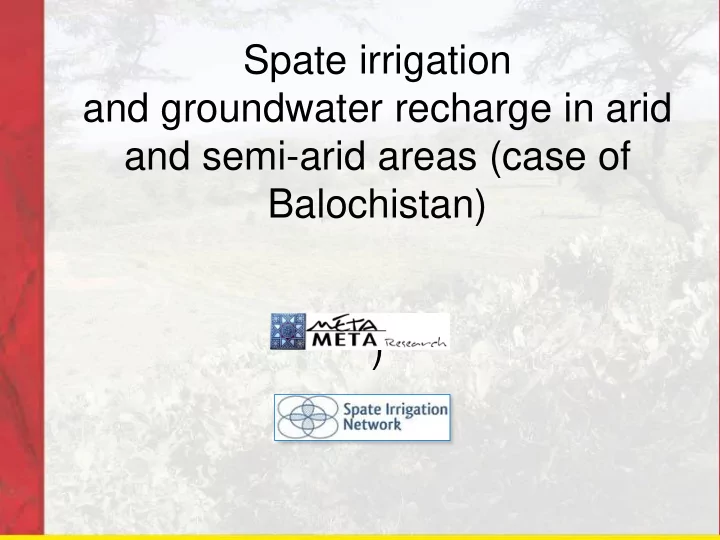

Spate irrigation and groundwater recharge in arid and semi-arid areas (case of Balochistan) )
GLOBAL IMPORTANCE OF GROUNDWATER 43% of irrigation in the world from groundwater 36% of potable water 24% of direct industrial water supply The trend is that this will increase: -Breakthroughs in pumping technology (solar pumping for instance) -Supermarket revolution – demands uniform produce produced with groundwater -Climate change – more reliance on the groundwater buffer
Yet the groundwater miracle is reaching its limits : The global recharge-discharge deficit is estimated at 20% Falling groundwater tables Groundwater pollution Salinization Compaction of aquifers and land subsidence Distorted ecosystems/ microclimate Subsurface space mismangement Conflicts and areas being abandoned
Balochistan no exception – in fact one of the ‘worst cases’ Concerns since 1980’s Growing population, growing agriculture, growing cities Groundwater collapses after periods of droughts In spite of studies and debates never systematic effective action Groundwater overuse is Balochistan single worst enemy
Groundwater Governance Vision - Principles ① Public guardianship and collective responsibility ② Effective management and stakeholder engagement at local level ③ Adequate and shared knowledge ④ Manage the linkages with land management and pricing > Several successful examples of local management
Joint mapping and farmer water schools in AP, India: Reduced overuse in all critical areas
Intense landscape treatment, Tigray - Ethiopia Using a range of techniques, applied in a short time frame (5 years): changed the micro-climate, controlled erosion and gullying and helped increase shallow groundwater levels
Be clever: systematically using roads for groundwater recharge 9
Can spate irrigation contribute to groundwater management in Balochistan
YES by making use of short term floods > Spate irrigation systems have: (1)Large potential to perform better and be expanded and contribute to food security (2)In the right locations can contribute significantly to the recharge of groundwater and subsurface flows
Extent and potential for spate irrigation This base year was a relatively dry year – the area under cultivation is normally higher
Improving spate irrigation: big opportunities – yields in Pakistan << 50% of elsewhere Rationalized water distribution Better moisture conservation Introduce best varieties Introduce agroforestry and better storage Special value chains Design for recharge!!
TWO STRATEGIES 1. OPTIMIZING RECHARGE FROM SPATE IRRIGATION 2. DEVELOPING GROUNDWATER RESOURCES IN DRY RIVER BEDS SAND DAMS AND SUBSURFACE DAMS
How to optimize recharge from spate flows? Recharge mainly from main riverbed – far less from main wadi flood channels or fields Recharge most effective from gravelly sections of the river bed Recharge most effective, if spate flows slow Recharge from flat sections of the river bed Recharge from water ponded at bunds and weirs Recharge from (subsurface) base flow Spread spate over large area to optimize recharge
What to do to optimize recharge from spate flows? Keep ‘ rough ’ gravel bed intact with floods flow ( more roughness bed) – be careful not to remove too much gravel Consider low weirs/ bed stabilizers to slow down the flow Avoid excessive siltation in main recharge section of the river bed Do not block the subsurface flow through cut-off weirs or bed stabilizers!!
Not a good idea : Wadi Siham spate irrigation system Yemen completely blocked subsurface flow and caused a dramatic drop in water levels in downstream wells
Good idea: Farmers in this downstream area argued for a change in the traditional water distribution – with more chance of a flood going downstream It was no so much the irrigation from the spate they were looking – instead they were interested in having their wells recharged
Good idea : LOW RECHARGE WEIR TO SLOW DOWN AND SPREAD FLOODS
Developing groundwater resources in dry river beds: Sand dams and subsurface dams
SAND DAMS – ACCUMULATE SAND BEHIND THE SMALL DAM BODIES – CREATING A STORAGE IN THE SAND LAYER – WITH LITTLE EVAPOTRANSPIRATION LOSS
(NON VENTED ROAD CROSSING DIONG
Subsurface dams: created underground barriers in dry river A subsurface dam will: Block underground flow of water Raise water level in the sand and gravel to for instance 30 cm below surface of riverbed
Agenda for action (1) Regulate groundwater use by activating community engagement in groundwater management (2) Use all best techniques to systematically recharge (shallow) groundwater including systematic development of spate irrigation
Recommend
More recommend